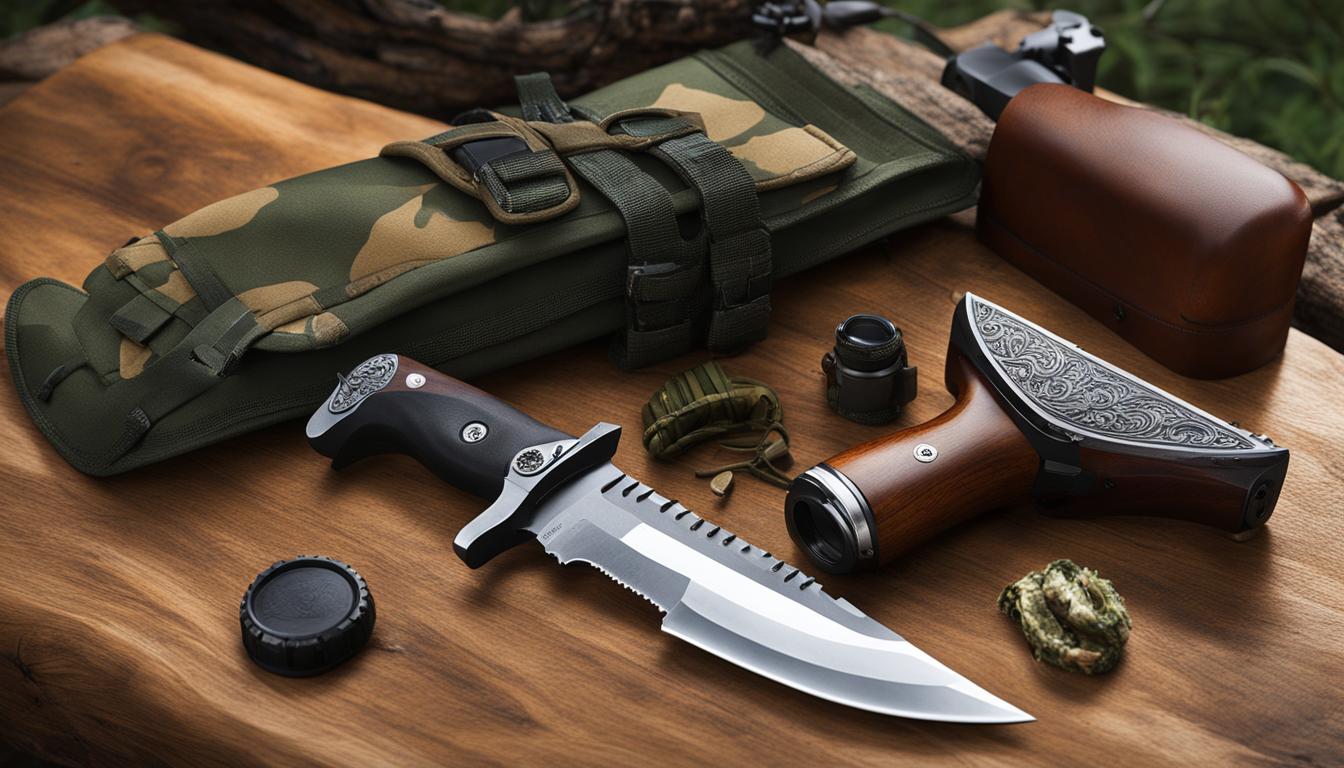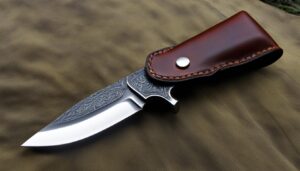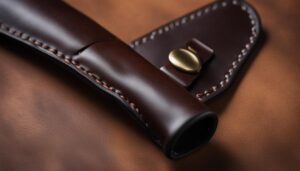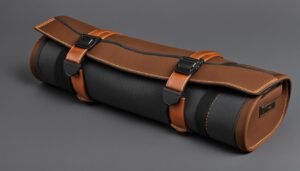Proper maintenance and care of your hunting knives are essential to ensure their longevity and optimal performance. By following these tips for safely storing your hunting knives, you can safeguard your knives, prolong their longevity, and prevent accidents.
Key Takeaways:
- Properly store your hunting knives to prevent them from rubbing against other utensils and becoming dull or damaged.
- Avoid tossing your knives into a drawer with other objects and use blade guards or individual sheaths for protection.
- Handle your hunting knives with care and avoid dropping them on hard surfaces.
- Transport your knives securely in a sheath or blade guard to prevent accidental cuts or injuries.
- Regularly sharpen your hunting knives using the appropriate tools and maintain their cutting performance with a honing rod.
Proper Cleaning and Drying Techniques for Hunting Knives
When it comes to maintaining your hunting knives, proper cleaning and drying techniques are essential. Not only will these practices help to preserve the longevity of your knives, but they will also ensure that your blades remain in optimal condition for your next hunting expedition.
To clean your hunting knife after each use, start by using warm, soapy water and a soft sponge or cloth. Avoid using abrasive cleaners or scrubbers, as they can scratch the surface of the blade. Hand-washing is recommended over using a dishwasher, as the high heat and harsh detergents can damage the knife.
After cleaning, it’s crucial to dry the knife thoroughly to prevent moisture from accumulating and causing corrosion or rust. Use a clean towel to carefully dry the entire knife, paying extra attention to the areas where water can easily collect, such as the hilt and the joint between the blade and handle.
https://www.youtube.com/watch?v=_iF_5yFmHPM
By following these proper cleaning and drying techniques, you can ensure that your hunting knives remain clean, dry, and in top-notch condition for many hunting seasons to come.
Appropriate Storage Options for Hunting Knives
Properly storing your hunting knives is crucial for their longevity and overall performance. By using the right storage options, you can protect your knives from damage and ensure they remain sharp and ready for use. Here are some recommended storage solutions to consider:
Knife Block
A knife block is a popular and practical storage option for hunting knives. It typically consists of a wooden block with slots to hold knives securely. The block helps to keep your knives organized, easily accessible, and protected from external factors that could dull or damage the blades. To avoid accidents, ensure that the knives are inserted with the blades facing downwards.
Knife Magnet
A knife magnet is another excellent storage option for hunting knives. It is a magnetic strip or board that securely holds knives in place. The magnet provides a safe and convenient way to store your knives while keeping them easily within reach. Make sure to position the magnet in a location away from children’s reach to prevent any accidents.
Knife Roll
If you often need to transport your hunting knives or have limited storage space, a knife roll might be the perfect solution. A knife roll is a compact, portable storage option that allows you to store multiple knives in one convenient package. It typically consists of a fabric roll with individual pockets for each knife. The roll can be easily rolled up for storage or transport, providing protection for your knives while on the go.
By utilizing these storage options, you can ensure that your hunting knives are kept in great condition and ready for use whenever you need them. Remember to always handle them with care and prioritize safety to prevent any accidents or injuries.
| Storage Option | Benefits |
|---|---|
| Knife Block |
|
| Knife Magnet |
|
| Knife Roll |
|
Handling and Transporting Hunting Knives Safely
When it comes to hunting knives, proper handling and transportation are crucial for both your safety and the longevity of your blades. By following some simple guidelines, you can ensure that your knives remain in top condition and prevent any accidental injuries.
First and foremost, always handle your hunting knives with care. These knives are sharp and should be treated with the utmost respect. Avoid dropping them on hard surfaces, as this can damage the blade or even cause it to break. When using your hunting knife, remember to use it for its intended purpose and avoid applying excessive force. Taking these precautions will help prevent any accidents or damage to the knife itself.
When it comes to transporting your hunting knives, it’s important to secure them properly to avoid any potential injuries. Always use a sheath or blade guard to cover the blade and keep it in place. This will not only protect you from accidental cuts but also prevent the blade from coming into contact with other objects that could cause damage.
Whether you’re heading out on a hunting trip or simply moving your knives from one location to another, ensuring safe transportation is key. Take the time to secure your hunting knives properly, and always double-check that they are securely fastened in their sheaths or blade guards. This way, you can enjoy peace of mind knowing that your knives are safely stored and ready for use whenever you need them.
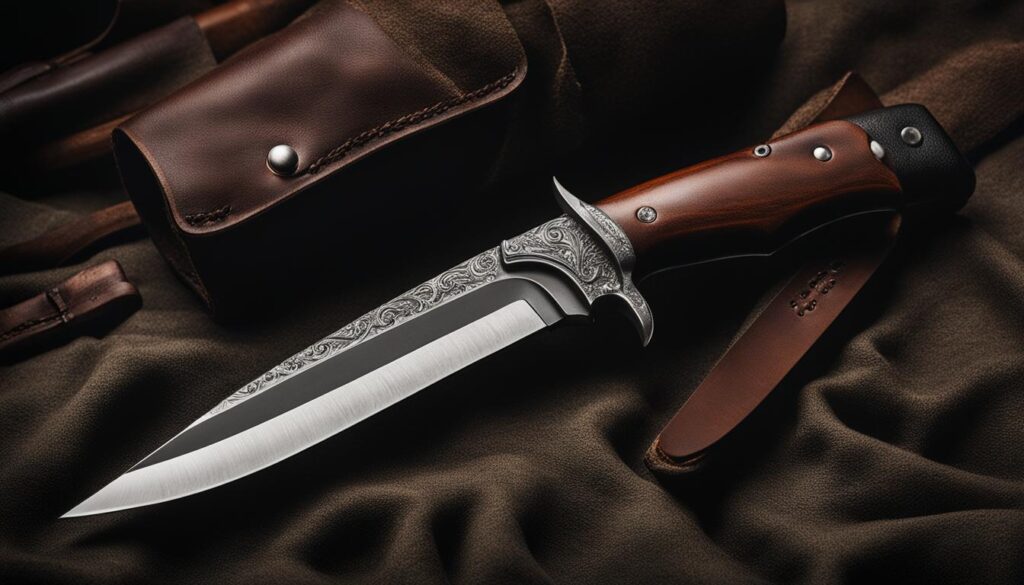
Table: A Comparison of Knife Handle Materials
| Handle Material | Pros | Cons |
|---|---|---|
| Wood | Traditional look and feel, good grip | Requires more maintenance, can be affected by moisture |
| G-10 | Excellent durability and grip, resistant to moisture | Can be more expensive |
| Micarta | Good grip, resistant to moisture, durable | Can be affected by extreme temperatures |
| Carbon Fiber | Lightweight, strong, and durable | Can be expensive, less grip compared to other materials |
As you can see from the table above, different handle materials offer various advantages and disadvantages. Consider your personal preferences and needs when choosing a hunting knife with the right handle material for you. This will ensure that you have a comfortable and reliable grip while using and transporting your knife.
Sharpening and Honing Hunting Knives Properly
Properly sharpening and honing your hunting knives is crucial for maintaining their cutting performance and prolonging their lifespan. Regularly sharpening your knives helps to maintain a sharp edge, which is essential for clean and precise cuts. Additionally, honing your knives between sharpenings helps to realign the blade, ensuring optimal cutting efficiency. By following the proper techniques for sharpening and honing, you can keep your hunting knives in top condition.
When sharpening your hunting knife, it’s important to use the right tools and techniques. A sharpening stone, such as a whetstone or oilstone, is commonly used to sharpen knives. Start by wetting the stone and holding the blade at the appropriate angle, usually around 20 degrees. Then, using gentle and controlled strokes, move the blade across the stone in a consistent motion. Repeat this process on both sides of the blade until you achieve the desired sharpness.
Honing your hunting knife is a quick and simple process that helps to maintain the knife’s cutting edge between sharpenings. A honing rod, also known as a sharpening steel, is commonly used for this purpose. Simply hold the rod upright and run the blade along its length, applying light pressure. Repeat this motion several times on both sides of the blade. Honing should be done regularly, especially after heavy use, to keep your hunting knife performing at its best.
| Sharpening and Honing Tools | Pros | Cons |
|---|---|---|
| Sharpening Stone |
|
|
| Honing Rod |
|
|
| Knife Sharpener |
|
|
Remember to always follow the manufacturer’s instructions when sharpening or honing your hunting knife, as different knives may require specific techniques or tools. With proper maintenance and care, your hunting knives will remain sharp and reliable, ensuring a safe and efficient hunting experience.
Conclusion
In conclusion, proper maintenance and care are crucial for the longevity of your hunting knives. By following the tips outlined in this article, you can ensure that your knives remain in optimal condition for years to come.
Knife maintenance is an essential aspect of owning hunting knives. Regular cleaning, drying, and sharpening are key to preventing corrosion, rust, and dullness. By cleaning your knives after each use and storing them in appropriate storage options, you can protect them from damage and maintain their sharpness.
Safe knife handling is of utmost importance to avoid accidents and injuries. Always handle your knives with care, using them for their intended purposes and avoiding excessive force. Properly securing your knives during transport is also crucial to prevent accidental cuts or injuries.
By prioritizing knife maintenance and safe handling, you can ensure the longevity of your hunting knives. With proper care, your knives will continue to serve you reliably, making your hunting experiences safer and more enjoyable.
FAQ
How should I clean my hunting knife?
After each use, clean your hunting knife thoroughly using warm, soapy water and a soft sponge or cloth. Avoid abrasive cleaners or scrubbers that can scratch the blade. Hand-wash your knife instead of using a dishwasher. Dry the knife completely with a clean towel, paying special attention to areas where moisture can accumulate. This will prevent corrosion and rust.
How should I store my hunting knives?
Store your hunting knives in a knife block, knife magnet, or knife roll to prevent them from rubbing against other utensils and becoming dull or damaged. Avoid tossing them into a drawer with other objects. If you must store them in a drawer, use blade guards or individual sheaths to protect the blades.
How should I handle and transport my hunting knives safely?
Handle your hunting knives with care and avoid dropping them on hard surfaces. Always use a knife for its intended purpose and avoid using excessive force. When transporting your hunting knives, make sure to secure them properly in a sheath or blade guard to prevent accidental cuts or injuries.
How can I keep my hunting knives sharp?
Keep your hunting knives sharp by regularly sharpening them using a sharpening stone, honing rod, or knife sharpener. Follow the manufacturer’s instructions or seek guidance from a professional if you are unsure how to sharpen your specific knife. Additionally, use a honing rod to straighten the edge of the blade between sharpenings to maintain the knife’s cutting performance.
What is the importance of proper maintenance and care for hunting knives?
Proper storage, cleaning, handling, and sharpening are essential for ensuring the longevity of your hunting knives. By following these tips, you can keep your knives in top condition, prolong their lifespan, and ensure safe knife handling. Remember to always prioritize safety when handling your hunting knives and use them for their intended purposes. With proper maintenance and care, your hunting knives will provide you with years of reliable service.
